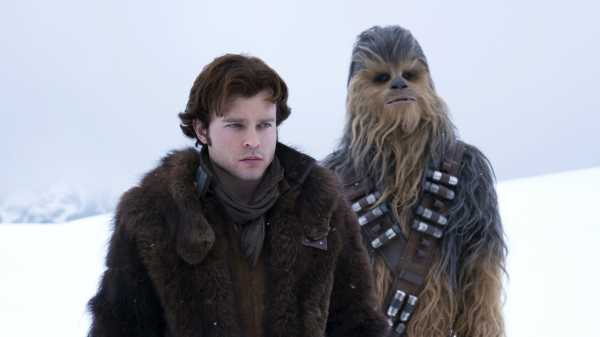
There’s a great deal of “Star Wars”-related information available in “Solo: A Star Wars Story,” but it’s sent in a very-low-bandwidth way that takes two hours and fifteen minutes to transmit. It’s like watching a live-action dramatization of a download progress bar, with actors carrying bits of information from one side of the screen to the other. In this way, too, the movie is a forced march in which the “Star Wars” cinematic empire strikes back. After the flamboyant, occasionally garish, but at least hardworking and inventive machinations of “The Last Jedi,” the franchise has gone back to its roots: the brazen reprocessing of tropes from classic-era Hollywood.
What “Solo” (directed by Ron Howard) has in common with “Casablanca,” for instance, even more than any plot twist or gesture, is its melodramatic portentousness. If the actors on “Solo” weren’t, like those of “Casablanca,” cracking up between takes at the cornball dialogue, it’s because of the sanctimonious reverence with which such high-budget, high-profit franchise movies are now regarded. Unlike “Casablanca,” which was a run-of-the-mill movie during its time, “Solo” is, from its very gestation, an event that must be taken seriously.
The movie at least fulfills its title: it’s an origin story about the young Han Solo, who’s introduced in circumstances designed to be called Dickensian. He’s in an orphanage of thieves run for the benefit of the worm-like overlord Lady Proxima (voiced by Linda Hunt) on the planet Corellia. There, Han (Alden Ehrenreich), an aspiring pilot, is doing a little stealing on his own behalf—he’s got a plan to escape, in the company of a young Corellian woman, Qi’ra (Emilia Clarke), with whom he’s in a relationship. (Little is said about Han’s background, though he does eventually let slip one notable detail—that his father, who had been an aspiring pilot, worked in and was laid off from a factory building starships of the sort that Han plans to fly.)
Han and Qi’ra, facing severe punishment, make their break from the hellish compound. With a blend of daring and fast-talking guile, Han gets them away—almost. In a wink at the 1938 film “Angels with Dirty Faces,” Han runs faster and gets out; Qi’ra, a step behind, gets stopped at the gate; and that makes all the difference. His mission is now not merely to pursue his own freedom; it’s to cultivate his flying skills, make some money, and devote his abilities and his resources to getting back to Corellia in order to get Qi’ra out.
The real star of “Solo” is the production designer, Neil Lamont, who takes the “long ago” part of the galaxy more seriously than the “far away” one, and includes plenty of historical movie-genre elements in the sets (or their C.G.I. supplements). For instance, Han volunteers to serve in the Empire’s armed forces, and the movie skips three years ahead to his time in combat—trench warfare reminiscent of the First World War, along with uniforms to match, in imagery borrowed from movies of the twenties and early thirties. Han’s insubordination leads to a punishment and then escape. He teams up with two other renegades, Beckett (Woody Harrelson) and Val (Thandie Newton), plus a certain Wookiee (Joonas Suotamo) and a rodent-like wise guy (voiced by Jon Favreau) to steal a shipment of the coveted fuel called coaxium. But the results of their heist put them into conflict with a big-time crime boss, Dryden Vos (Paul Bettany), who dispatches them on another mission.
In need of a spaceship for yet another heist, Han heads to the Cantina to play cards against the owner of the Millennium Falcon—the high-stakes gambler Lando Calrissian (Donald Glover), vaguely literary and vaguely mannered (an intergalactic Doc Holliday). They team up, joined by L3-37, a female robot (voiced by Phoebe Waller-Bridge) who’s in a relationship with Lando, and who is by far the most unusual and piquant creation in the movie. The notion of human-robot love is more interesting from the robot perspective—the gendering of a robot , for instance, remains to be explored, but “Solo” isn’t a movie that explores it. Instead, the tropes and twists of shamelessly recycled clichés are presented throughout with an absurd earnestness.
The MacGuffin is coaxium, which, like oil, needs to be extracted from belowground and refined before it can be used. The process of refinement—implicating facilities on the planet of Savareen—becomes crucial to the action. (It helps that the Millennium Falcon can make the Kessel Run in less than twelve parsecs.) That planet is depicted as a version of a subjugated Middle Eastern petro-colony, inhabited by people who wear caftans and headscarves, built on sand, featuring tents alongside high-tech trappings and a tangle of worn pipes and valves. Yet it’s not much of a spoiler to say that Savareen is the site of a climactic showdown, one that, even more than it caps the action, unites in a single sequence the Western-movie threads that had been gathering throughout the film.
Ron Howard’s direction is as foursquare as the nineteen-forties serials on which “Star Wars” was inspired. “Solo” exists to deliver its script (by the son-and-father team of Jonathan Kasdan and Lawrence Kasdan) and would have found its ideal form in a filmed table read. Instead, the movie takes its fine cast members and turns their performances into classic-Hollywood cosplay. But Howard’s bland direction does have the virtue of an accidental transparency: it highlights the underpinnings of George Lucas’s “Star Wars” series over all. The “Star Wars” cinematic universe takes the frameworks, moods, tropes, and signifiers of classic Hollywood movies and surgically extracts the moral complexity—reducing them to a universe of brightly lit verities that, in the outer-space setting with its elaborate special effects, has a very particular point: to show that, as complex as modern life may be, the ostensibly obvious moral truths still and always hold. (What Lucas accomplished, in his own prequels, was to add a thick and intricate texture of intellectual complexity, to show the elaborate workings of power that churn beneath the Manichean surfaces—and that risk blurring their clear lines.)
The nature of those truths, as they reach back to the start of the series and emerge foregrounded in “Solo,” is distilled in a key moment in the new movie, when Han identifies himself as an “outlaw” and Qi’ra responds that she knows who he really is: “the good guy.” The paradox is no paradox: the outlaw is something very different from a criminal. He (it’s almost always a “he”) is more than a mere breaker of laws. Rather, the outlaw is someone who remains unconstrained by law in the assertion of his own moral authority; that’s why the outlaw is the good guy. The tragic awe that this paradigm brought to bear on the best of classic Westerns is reduced, in the “Star Wars” series—and spotlighted in “Solo”—as an untroubled measure of self-evident and unquestioned virtue. That’s why “Star Wars” is among the cultural creations that laid the groundwork for Ronald Reagan’s reign of nostalgic homilies—and why “Solo,” regardless of its diverse cast and its nods in the direction of the politics of liberation, reinforces the mythos of the old-fashioned, plain-spoken, risk-taking rule-breaker for the current reign of crude and vain male swagger.
Sourse: newyorker.com






